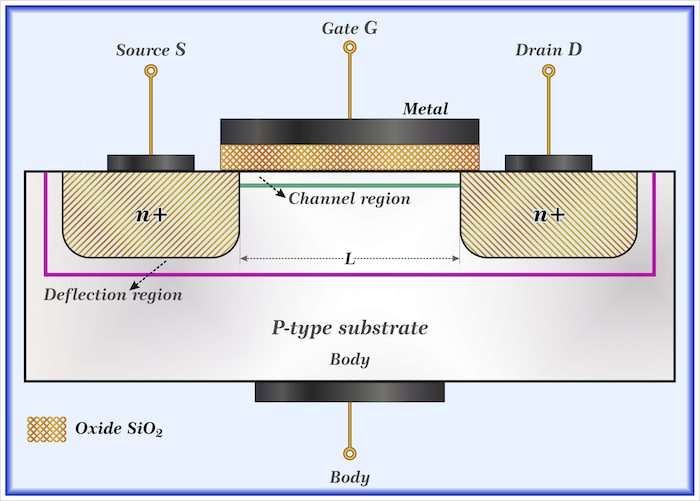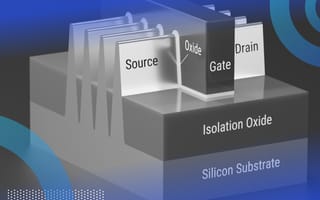A field-effect transistor (FET) is a type of transistor that uses an electric field to control the current flow through a semiconductor channel. FETs are widely used in electronic circuits due to their high input impedance, low gate current and potential for high output impedance (depending on the circuit configuration).
How Does a Field-Effect Transistor (FET) Work?
FETs have three terminals: the source (S), the drain (D) and the gate (G). When we apply a voltage to the gate, it creates an electric field that either attracts or repels the charge carriers (electrons or holes) in the channel region. Whether the charge carriers are attracted or repelled depends on the voltage’s polarity. The process of applying a voltage to the gate of the FET controls the channel’s conductivity and the current flow between the source and drain terminals.

Characteristics of a Field-Effect Transistor (FET)
Voltage-Controlled Device
An FET is a voltage-controlled device. This means that its output current is controlled by the voltage we apply to its gate terminal.
High-Input Impedance
FETs have very high input impedance, which means they do not load down the signal source and can be used as buffer amplifiers. Using FETs as buffer amplifiers can help prevent signal distortion and improve the overall quality of the circuit’s output. Additionally, FETs are power-efficient, which makes them an attractive choice for battery-powered devices.
Unipolar Device
FETs are unipolar devices, which means they use only one type of charge carrier (electrons or holes) to control the current flow. This simplifies their behavior and often reduces noise, but also impacts gain and switching characteristics compared to bipolar transistors. The alternative to a unipolar device is a bipolar device. Unlike a unipolar device like an FET, a bipolar device such as a Bipolar Junction Transistor (BJT) uses both electrons and holes to control the current flow. Bipolar devices have a high current gain and can handle higher power levels, which makes them suitable for power amplification applications.
3 Terminals
The source, the drain and the gate are an FET’s three terminals. The source and drain are connected to the channel, while the gate controls the flow of current through the channel.
Channel Conductivity
We can control the conductivity of the channel in an FET by the voltage we apply to the gate. In an n-channel FET, a positive voltage applied to the gate will attract electrons to the channel and increase its conductivity. In a p-channel FET, a negative voltage applied to the gate will attract holes to the channel and increase its conductivity.
Types of Field-Effect Transistors (FETs)
Junction Field-Effect Transistor (JFET)
In a JFET, the channel consists of a semiconductor material and the channel has two regions at each end. These are known as the source and the drain terminals. The gate is a PN junction that’s formed perpendicular to the channel. In an n-channel JFET, the gate is typically biased negatively relative to the source, creating a depletion region that controls the width of the channel. When we apply a voltage to the gate, the depletion region widens, thereby reducing the channel width and the current flowing through it.
Metal-Oxide-Semiconductor Field-Effect Transistor (MOSFET)
Similar to JFETs, in MOSFETs the channel is also formed by a semiconductor material and it has two regions at either end, known as the source and drain terminals. In a MOSFET however, the gate is separated from the channel by a thin insulating layer that typically consists of silicon dioxide. As soon as a voltage is applied to the gate, it creates an electric field that attracts or repels charge carriers in the channel, depending on the voltage’s polarity. This process controls the width of the channel and the flow of current between the source and drain terminals.
MOSFETs can be further classified into two subtypes: enhancement-mode and depletion-mode MOSFETs.
Enhancement-Mode MOSFETs
In enhancement-mode MOSFETs, the channel is normally off and you must apply a positive voltage to the gate in order to turn it on.
Depletion-Mode MOSFETs
In depletion-mode MOSFETs, the channel is normally on and you must apply a negative voltage to the gate to turn it off.
Advantages of Field-Effect Transistors (FETs)
FETs have several advantages over other types of transistors, which make them popular in a variety of electronic applications.
- High-input impedance: FETs have very high input impedance, which means we can use them to buffer and amplify signals without loading down the signal source. As a result, FETs are ideal for use in preamplifiers, mixers and other signal processing circuits.
- Low noise: FETs have low noise levels, which means we can use them in low-noise amplifiers and other applications where noise is a concern.
- Low power consumption: FETs require very little power to operate so they’re ideal for battery-powered devices and other low-power applications.
- Fast switching speed: FETs have very fast switching speeds, which make them ideal for use in digital circuits, switching power supplies and other high-frequency applications.
- Temperature stability: FETs have excellent temperature stability, which means their performance remains consistent over a wide range of temperatures.
- High voltage handling capability: Certain types of MOSFETs (such as those designed for power electronics) can handle high voltages, which makes them suitable for use in high-voltage circuits such as power amplifiers and power supplies.
Disadvantages of Field-Effect Transistors (FETs)
Despite their advantages, FETs nevertheless have some disadvantages we should consider when designing electronic circuits.
- Sensitivity to static electricity: FETs are sensitive to static electricity, which can damage the device during handling or assembly.
- High-input capacitance: FETs have high input capacitance, which can limit their bandwidth and speed in certain applications such as high-frequency amplifiers or circuits where the input capacitance of the FET can limit the circuit’s bandwidth.
- Temperature dependence: While FETs have good temperature stability, their performance can still be affected by changes in temperature, particularly in high-power applications such as power supplies where the FETs are subjected to high levels of current and power dissipation.
- Lower gain than bipolar transistors: FETs have lower gain than bipolar transistors. This property can make FETs less suitable for certain amplifier applications, particularly those that require high levels of gain or have a weak input signal. In these applications, you may prefer bipolar transistors due to their higher current gain.
- Limited power handling capability: FETs have limited power handling capability compared to some other types of transistors, which can limit their use in high-power applications.
- Limited frequency range: Some types of FETs have a limited frequency range, which can limit their use in high-frequency applications.
Frequently Asked Questions
What is a field-effect transistor (FET)?
A field-effect transistor (FET) is a type of transistor that controls current flow through a semiconductor channel using an electric field applied via the gate terminal.
What are the main parts of an FET?
A field-effect transistor (FET) has three terminals: the source, the drain and the gate. The gate voltage regulates current between the source and drain.
How does an FET differ from a bipolar junction transistor (BJT)?
FETs are unipolar devices using one type of charge carrier, while bipolar junction transistors (BJTs) are bipolar and use both electrons and holes. BJTs typically offer higher gain, but lower input impedance.





